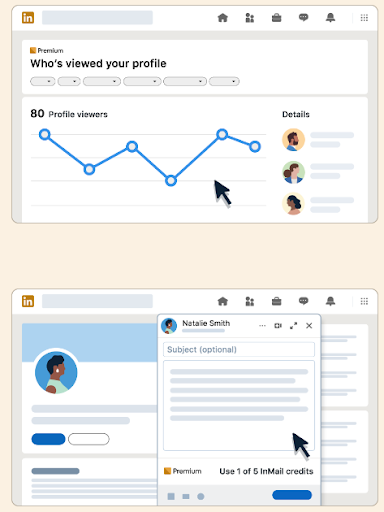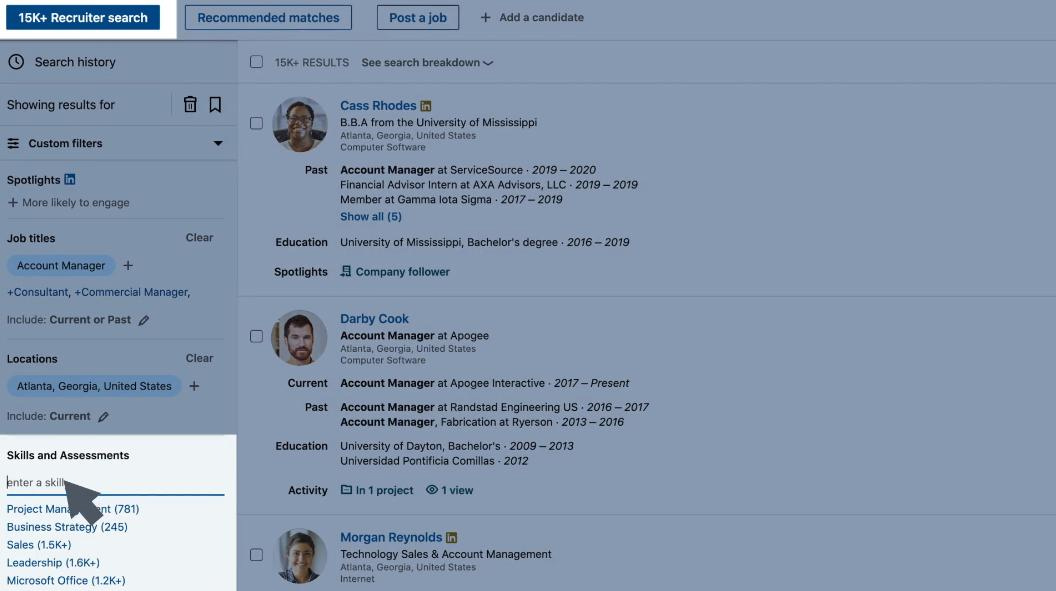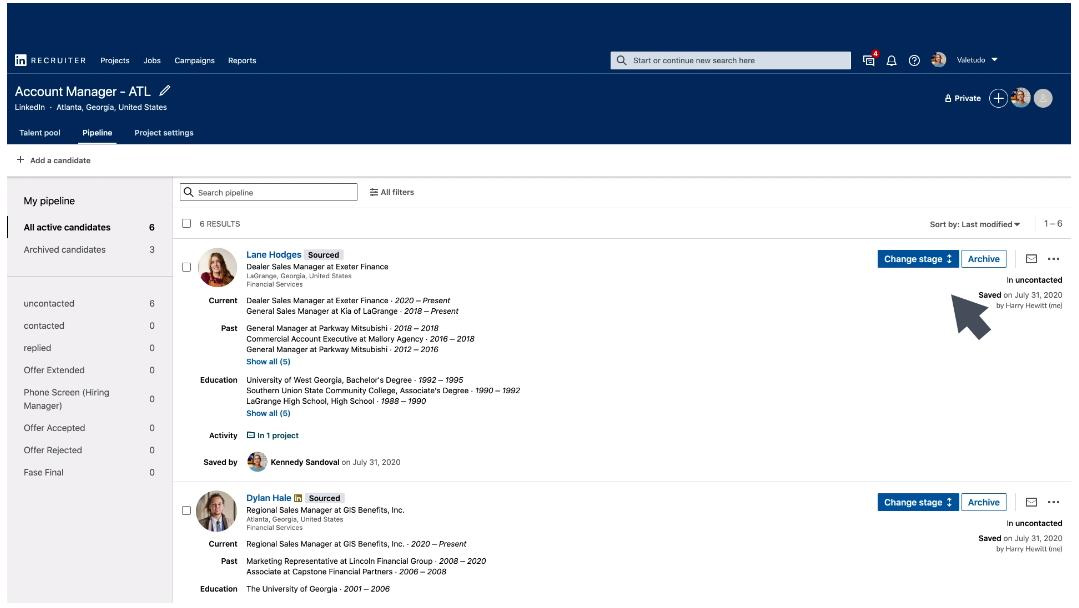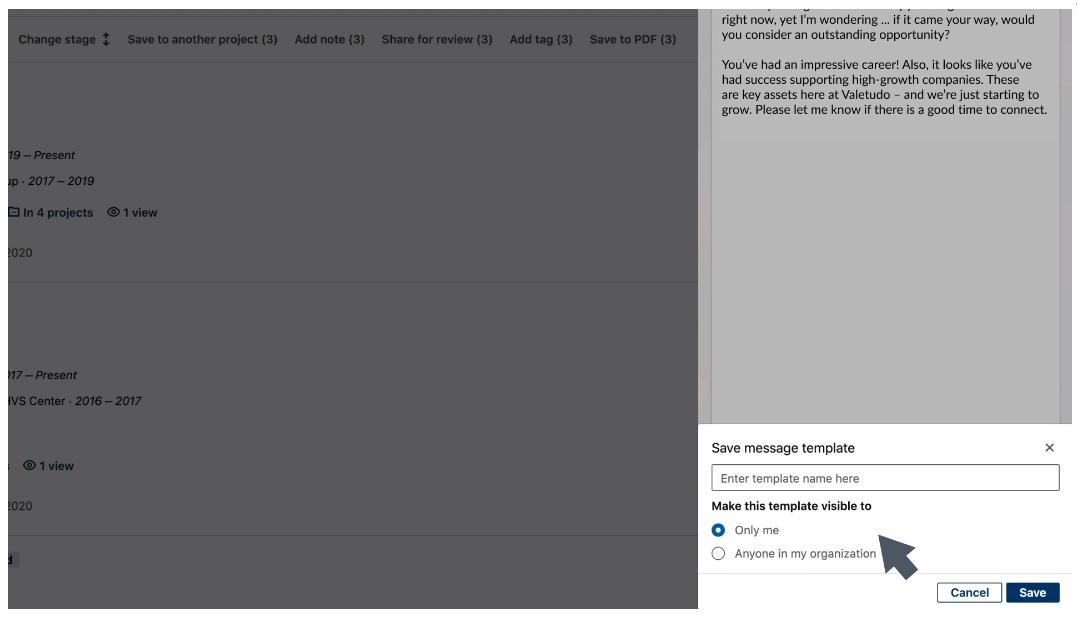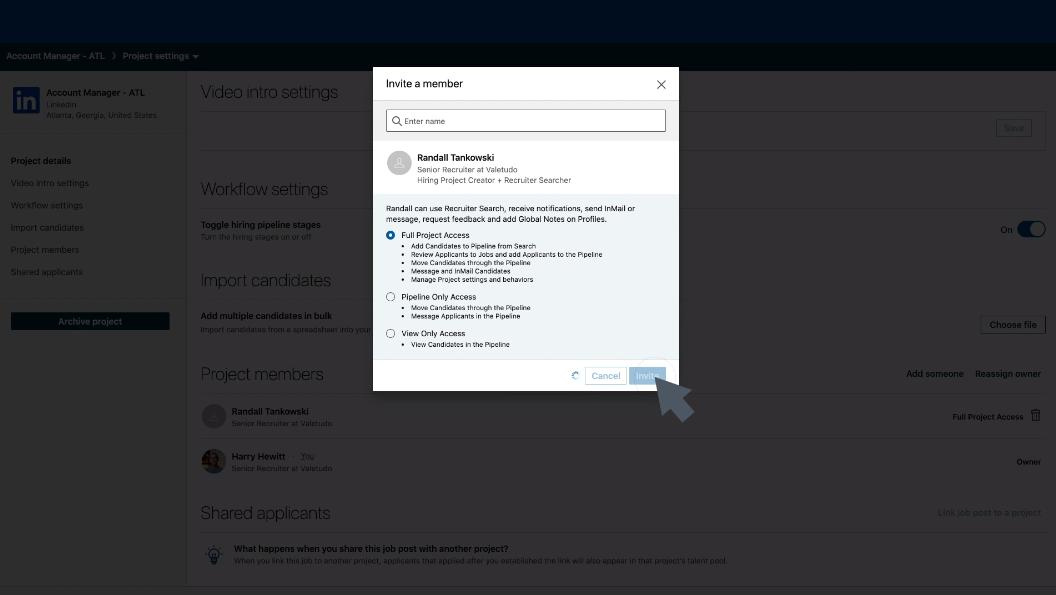LinkedIn is one of the most popular social media networks and the only one dedicated to business and professional networking. It’s the best place to promote your company as a great place to work and an industry leader. Plus, its free tools and paid plans harness the power of LinkedIn’s network to promote job openings and recruit new employees.
Businesses can use LinkedIn for a number of initiatives, such as business exposure, networking, lead generation, and building brand awareness. For the purpose of this LinkedIn review, we’ll be focusing primarily on using it as a recruiting platform deriving scoring from our Best Recruiting Apps for Small Businesses buyer’s guide.

Pros
- Free plan has excellent tools for networking and researching talent
- Top platform for recruiting
- Professional focus
Cons
- Hard to contact support
- Paid ad pricing can be expensive
- Costs extra to contact people out of your network
Deciding Factors
- Affordable: Free plan allows for networking and job posting.
- Easy to use: In addition to the social media-style pages, posting, and messaging, the advertising works similarly to Google AdWords.
- Large professional network: LinkedIn is a worldwide social media platform with over 1 billion members.
- Research candidates: Candidate profiles show experience, skills, recommendations, and more.
- Social recruiting program: LinkedIn Recruiter lets you conduct in-depth searches for talent, reach out to potential candidates, and track applicants.
- Promotes job openings and recruiting events: Post jobs on your LinkedIn business page or create sponsored ads.
- LinkedIn InMail: Message potential and current candidates.
LinkedIn’s profile and business pages are free and easy to put together. It offers a paid plan specifically for recruiting, but its free tools are easy to use for research and reaching out to potential candidates.
In short, LinkedIn is best for:
- Businesses recruiting qualified professionals: LinkedIn’s profiles allow people to post resume-type information and other details that show them as thought leaders and industry experts.
- Businesses looking to find passive candidates through networking: LinkedIn’s social media nature and instant messaging tools make it easy to reach out to connections, even those not actively looking for a job.
- Businesses hiring managers and leaders: LinkedIn is one of our top choices for seeking people for leadership positions. LinkedIn is full of professionals in many different fields, and they typically have a filled resume with general and leadership skills.
- Businesses looking for qualified international hires in professional fields: While the US has the most users per individual country (more than 220 million), the combined number of LinkedIn users outside the US makes up about 75% of its total 1 billion users. Thus, it’s a good place to look for international employees
LinkedIn may not be right for you if you are a business:
- Needing hourly or unskilled labor: LinkedIn is a powerful tool for finding and hiring employees—but candidates on the platform are typically white-collar workers and industry specialists. If you are looking for blue-collar, hourly, or young workers, such as for retail or restaurants, you may want to check out our list of the best recruiting software.
- Hiring freelancers: While you can seek and contact freelancers for jobs on LinkedIn, you may streamline your search by using more powerful platforms for finding freelancers and gig-based workers instead.
How LinkedIn Compares With Top Alternatives
Best For | Starter Fees | Standout Features | Our Review | |
|---|---|---|---|---|
 | Recruiting professionals | $0 |
| |
 | Applicant tracking system functions & background screening | $0 |
| N/A |
 | Free job posting | $0 |
| |
 | Finding professional freelancers | $0 + 5% fee |
| |
LinkedIn offers free and paid premium plans. In addition to the plans listed below, it offers a Sales Navigator plan primarily for identifying potential clients rather than potential employees. Below are the plans that allow you to find, connect with, and potentially hire new employees.
- Free: Allows you to create a profile and business page and begin browsing and connecting with others
- Premium Career ($29.99): For candidates rather than recruiters; helps job seekers get on employers’ radars
- Premium Business ($59.99): Used primarily for promoting your business, it can help you get the attention of qualified job seekers
- Recruiter ($170 to $1,080 per month)
Discount available if paid annually
: If the free tools are not enough, this plan gives you an extra boost with detailed search and improved InMail reach (InMail is LinkedIn’s messaging feature)
- LinkedIn Recruiter Lite: $170 per month
- LinkedIn Recruiter Professional Services: $895 per month
- LinkedIn Recruiter Corporate: $1,080 per month
Many small businesses find the free plan sufficient for their day-to-day needs, but you can always upgrade to a paid plan for a limited time, such as when you are in a hiring surge. LinkedIn also offers a free 30-day trial of each Premium plan. After that time, it will start billing unless you cancel. It warns you seven days before your trial ends, which is a courtesy we don’t always see in subscribed services.
LinkedIn Plans at a Glance
Free | LinkedIn Premium Career | LinkedIn Premium Business | LinkedIn Recruiter | |
|---|---|---|---|---|
Cost per Month | $0 | $29.99 | $59.99 | $170+ |
Profile Page | ✓ | ✓ | ✓ | ✓ |
Connect With Others | ✓ | ✓ | ✓ | ✓ |
Search Profiles | ✓ | ✓ | ✓ | ✓ |
See Who Has Viewed Your Profile in the Last 90 Days | ✓ | ✓ | ✓ | ✓ |
People Browsing (Level of Connection Accessible) | Third degree | Third degree | Third degree | Third degree, advanced search filters, candidate search alerts |
Send Inmail (to Those Not in Your Network) | ✕ | 5 | 15 | 30-150 |
Business Insights | ✕ | Company and job applicant | Company and job applicant | InMail performance, company, and job analytics |
LinkedIn Learning Access | ✓ | ✓ | ✓ | ✓ |
Access LinkedIn Interview Prep Tools | ✓ | ✓ | ✓ | ✓ |
Advanced Plans | ✕ | ✕ | ✕ | Includes team collaborators, more searches, more filters, out-of-network search |
Expand the sections below to learn more about each of LinkedIn’s paid plans.
You can post job ads on your business page for free, but for active recruiting, LinkedIn Recruiter gives you access to its network of over 1 billion professionals. You can filter searches by skills, location, or other requirements and pare down the list to those who say they are actively interested. Artificial intelligence (AI) also learns from your searches to make recommendations for you.
You start by creating a project, then finding your candidates and adding them to the project. This makes organizing easier. Next, you can reach out to prospects via InMail. You get 30 to 150 credits a month (depending on which plan you select), with credits expiring after 90 days, so you don’t have to use them all in a month. You can also make message templates and send out group messages. As candidates reply, you can save them, make notes, and more.
With Recruiter (as opposed to Recruiter Lite), you can bring in team members or clients to the conversation. They can view applicants without logging into LinkedIn. They can also add notes. If you have an applicant tracking system, the Recruiter Plan lets you integrate those as well.
LinkedIn Recruiting is a powerful platform. We only touch on the basics here, but you can read our article on finding employees with LinkedIn to get more details and advice.
LinkedIn is designed as a professional networking solution. Therefore, while it offers features similar to most social media platforms, it focuses on business: making contacts, hiring employees, and showing your business in its best light to both customers and potential new hires.
Business LinkedIn Pages
The business account (LinkedIn Page) is about your company—its mission, employees, advertising, jobs, etc. You gain followers rather than connections. Savvy job seekers research the companies they are interested in—and LinkedIn, along with your careers page on your website, is one of the best ways to learn more about you.
Tip: You need a personal page to set up a business page. However, you cannot post job ads to a personal page—this is only available with Business Pages. You can always transition to a business page if you grow. Check out LinkedIn’s guide for how to do just that.
You can post to any of the tabs on your Business Page (About, Posts, Jobs, Video) for free. You can also create events for free. The People tab shows demographics about your employees that LinkedIn has collected based on their personal accounts.
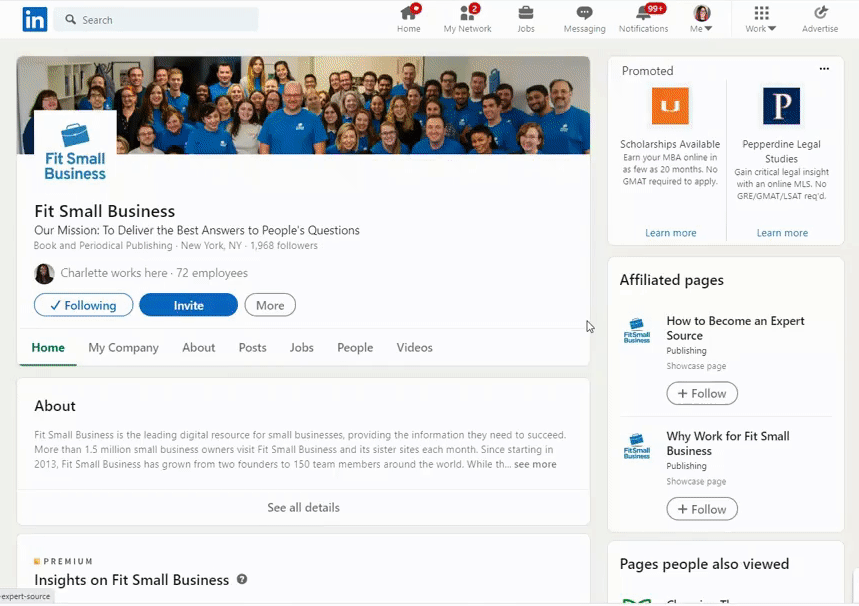
A business page showcases your company and its employees. (Source: LinkedIn)
Personal Profiles
As a business owner or recruiter, your personal page can introduce you and your company to a broader business audience, help build a network you can tap into to fill open roles, establish your credibility in the market, and more. There’s no reason not to have a personal profile, and you need one to create a Business Page.
Personal profiles are also a great resource for looking at potential candidates. You can either search profiles or look up a profile of someone who has applied or been recommended to learn more about them.
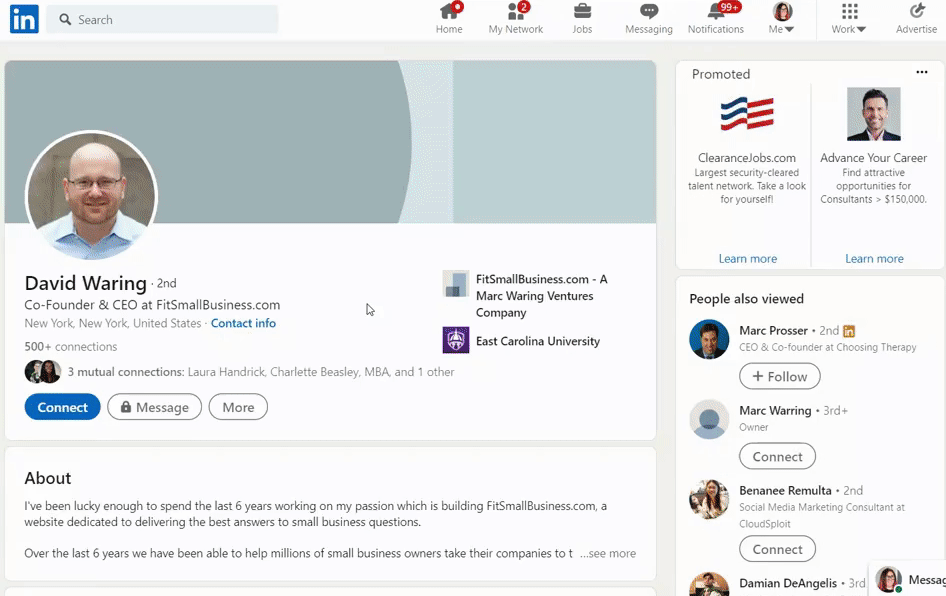
A personal profile is much like an online resume and portfolio. (Source: LinkedIn)
LinkedIn’s personal profile is designed to be like a resume and has places for endorsements from previous managers or coworkers. People can indicate if they are looking for work or are open to opportunities. LinkedIn has skills assessment tests with badges for the person’s page, and they are noted when someone does a recruitment search. In addition, posts tend to display their expertise in their field, as opposed to the lighter antics of TikTok.
InMail
InMail is LinkedIn’s messaging feature, but with a twist. Unless you have a premium plan, you can only contact people with whom you are connected. Paid plans offer a limited number of InMail messages per month, between 30 and 150, to contact people outside your network. In this way, you can reach out to job candidates even if you are not connected with them.
Sponsored messages are promotional or informational ads that are part of a marketing or hiring campaign. You can target these by profile information like position title, industry, or region. They don’t count for message credits in your InMail system but are paid for on a cost-per-send or cost-per-displayed basis. Learn more on LinkedIn.
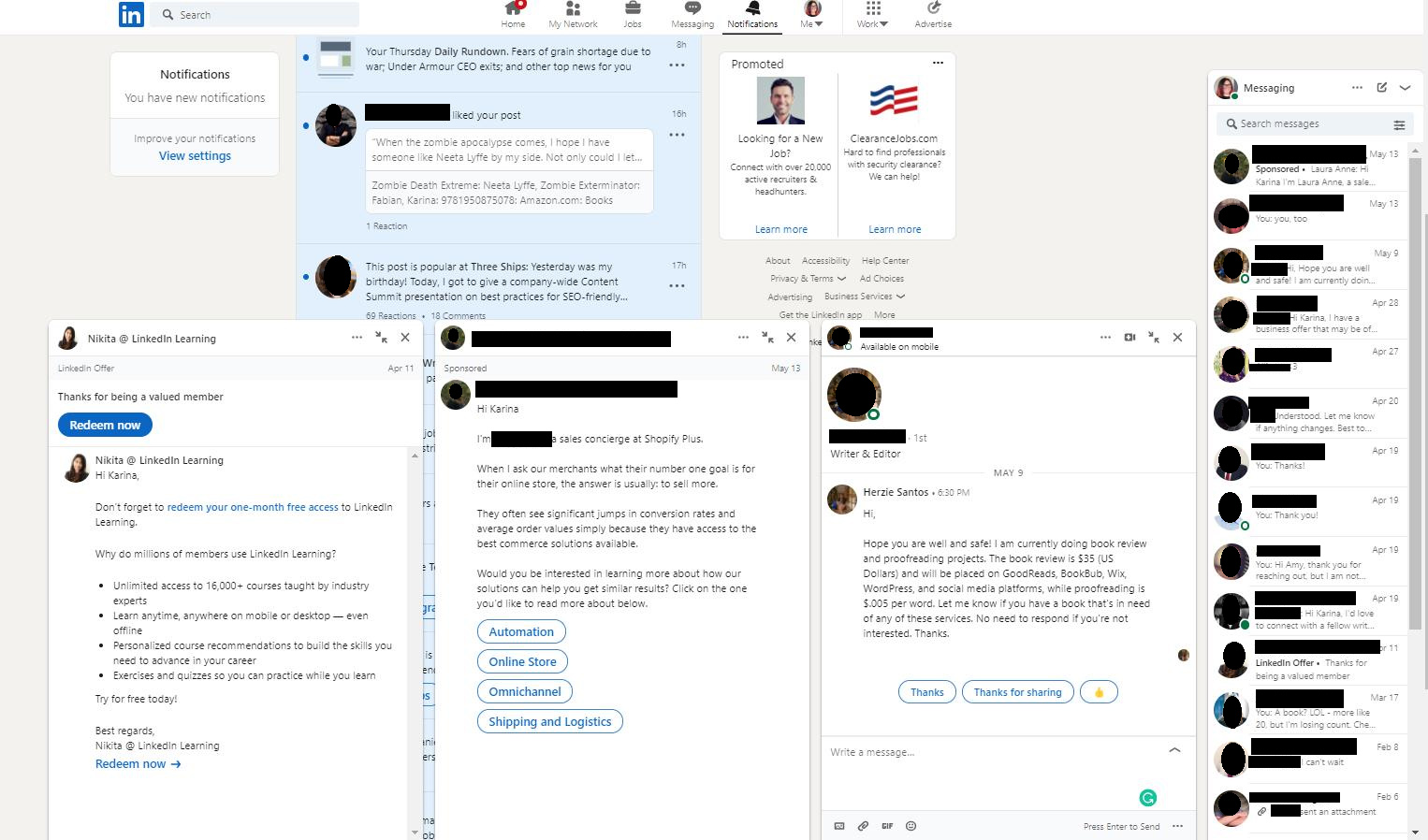
LinkedIn offers multiple levels for emailing, which determines who you can send to. (Source: LinkedIn)
LinkedIn Groups
Like other social media platforms, LinkedIn lets you form or join groups, which are private spaces for viewing, posting, and commenting on posts with other group members. Users within the same group can also send messages to each other through InMail. Use this to find candidates in your alma mater or through professional organizations like the National Society of Professional Engineers.
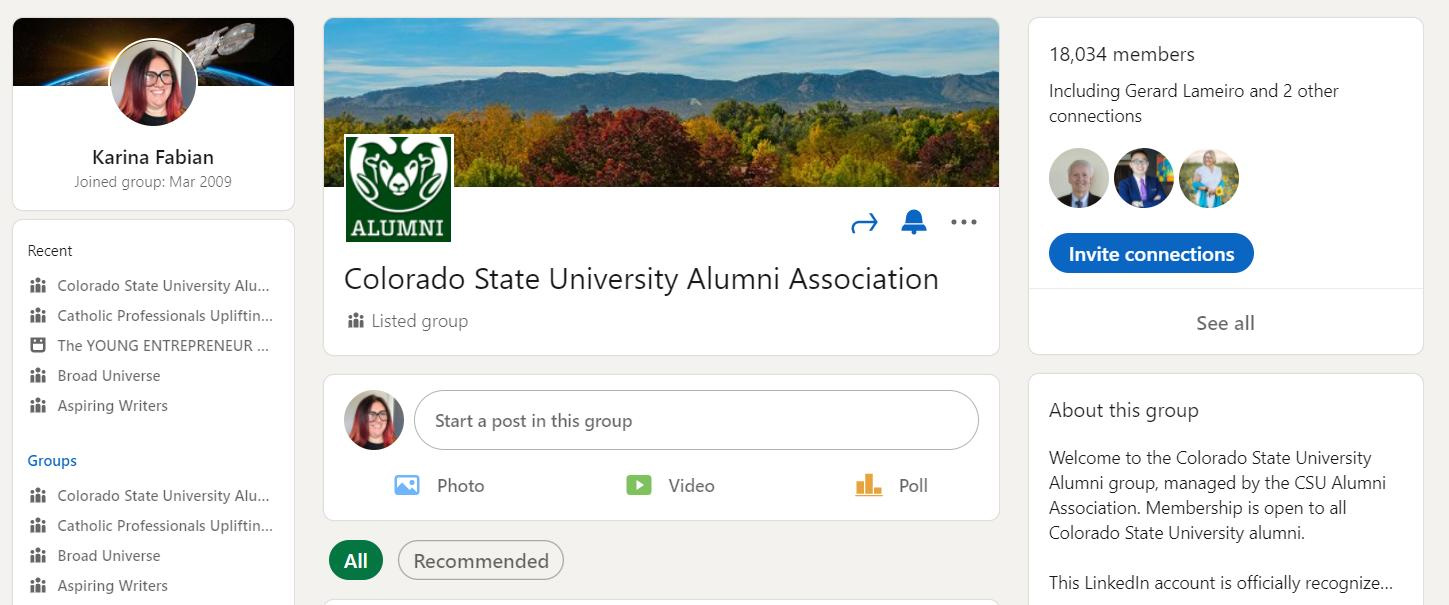
Groups center around shared interests, from alumni to professional organizations to shared goals. (Source: LinkedIn)
LinkedIn Events
Personal profiles and business pages both have the option to let you create events, such as meetups, workshops online, or webinars. They can be in person, online, or via LinkedIn Live. You can use this to create or announce recruiting events or job fairs.
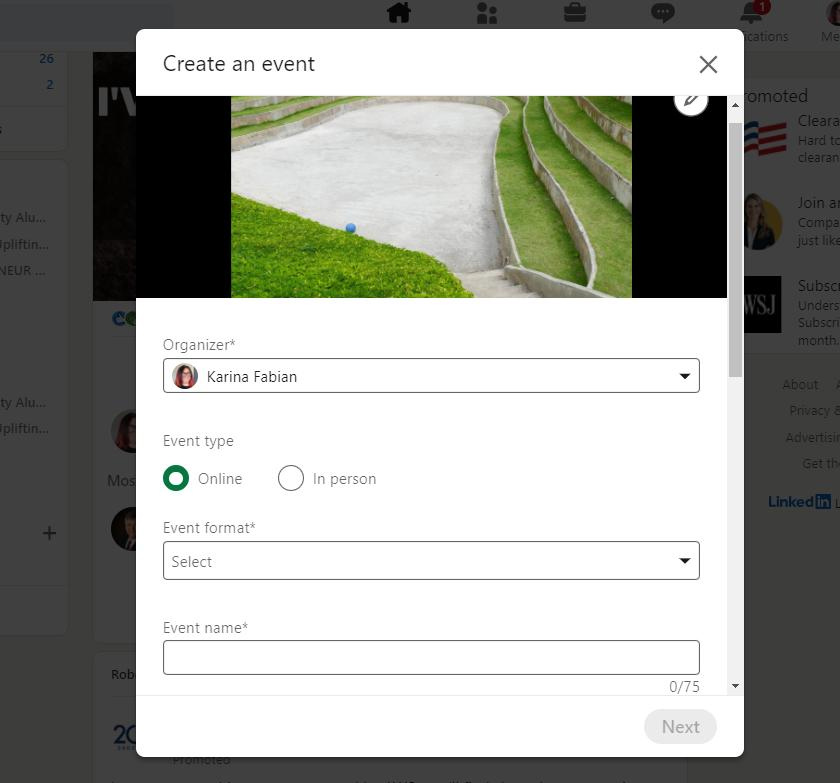
You can add events from your newsfeed. (Source: LinkedIn)
LinkedIn Ads
If you want greater publicity for your job postings, LinkedIn has impressive tools through Sponsored Content. It can take the form of text, images, video ads, and even sponsored InMail messages. This is similar to Facebook.
In addition, you can create original ads, which are called Direct Sponsored Content. You pay for ads by objective, such as visits to your careers page. In that case, LinkedIn only charges if someone clicks the website link on your ad. This makes it comparable to Google Ads and Indeed, plus the interface is similar.
In addition to creating ads, you can retarget them to reach specific audiences based on actions. For example, you can send ads specifically to people who recently visited your careers page. Retargeting depends on the ad, action, and desired result. Learn more on LinkedIn.
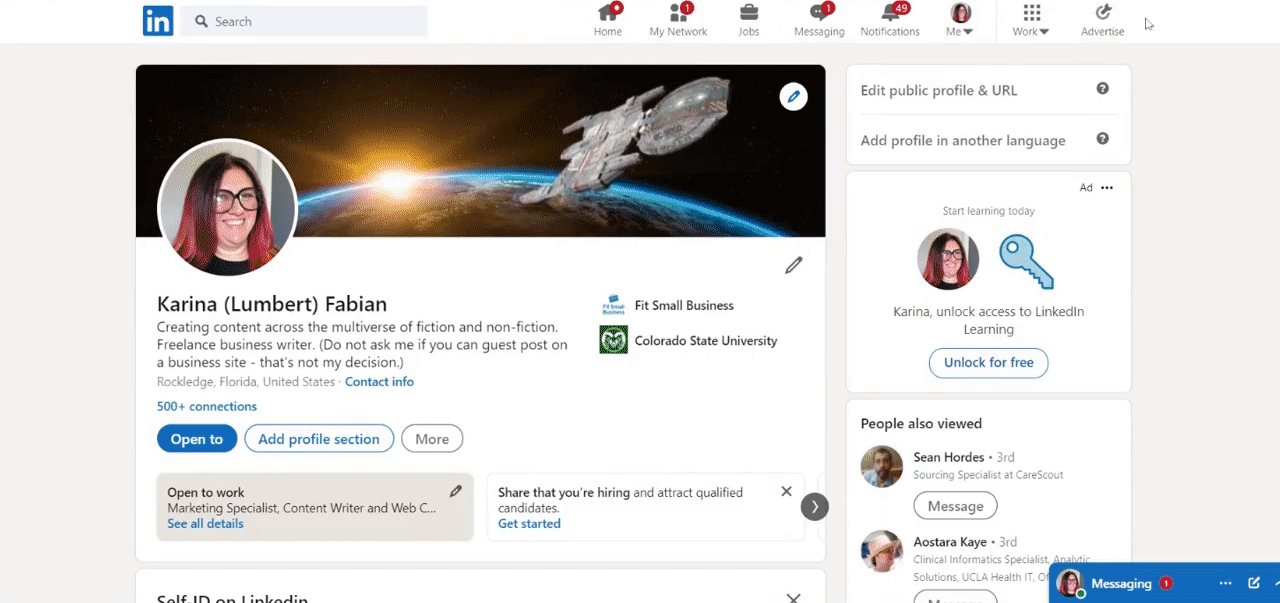
Caption: The LinkedIn Campaign Manager interface is similar to Google Ads. (Source: LinkedIn)
| Users Like | Users Don’t Like |
|---|---|
| Super easy to use | Paid plans and PPC pricing are expensive |
| Excellent for business networking | Support hard to reach |
| Like that it’s business-specific and professional | Can get spammed by other LinkedIn members (via InMail) |
Overall, private and business users who left LinkedIn reviews said that they loved both the paid and free plans of the platform. They appreciated the business focus of the platform—which made networking and lead generation easier—and found the tools overall effective. The two main complaints were the prices, especially for ad campaigns, and that support was hard to reach. Overall, however, people say LinkedIn was well worth the time and effort they put into it.
While LinkedIn scored 5 out of 5 for popularity in our review, due to receiving scores higher than 4 out of 5 and over 1,000 reviews combined, their scores were slightly lower on third-party user review sites.
- Capterra:
- LinkedIn Recruiter, 4.6 out of 5 (over 90 reviews)
- LinkedIn for Business, 4.6 out of 5 (over 1,500 reviews)
- G2:
- LinkedIn Recruiter, 4.4 out of 5, (over 300 reviews)
- LinkedIn Recruitment Marketing, 4.2 out of 5, (over 800 reviews)
With LinkedIn Recruiter you can create and customize analytics reports (within a two-year data range) based on users, projects, and applicants. Additionally, you can create your own data sets that align with your organizational goals. From there, custom reports can be exported for further analysis and/or integration with other data sources.
The following reports can be captured on LinkedIn:
- Summary report: utilization and performance metrics
- Pipeline report: data from individual projects and talent pipelines
- Usage report: metrics for all users
- InMail report: usage and performance data in messaging
- Jobs report: job posting performance insights
- Hiring funnel: data on how LinkedIn users interacted with paid solutions before applying for jobs
- ATS Applicant tracking system -enabled hiring funnel: data collected from stages—applied, hired, aware, engaged, and considering
- ATS-enabled source: data on the source of hire and the quality and quantity of candidates from each source
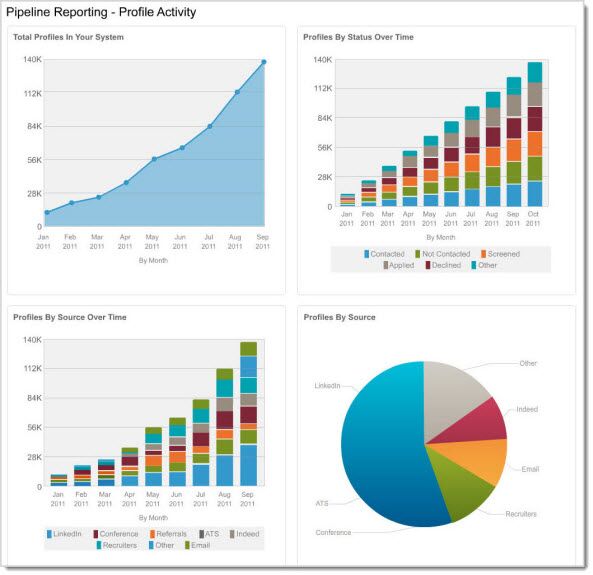
Example of pipeline report in LinkedIn (Source: LinkedIn)
The LinkedIn mobile app lets you do all the front-facing tasks that the online version does, including:
- Business and social networking
- Posting on your feed
- Candidate research
- Messaging
- Schedule events
However, you need to access the online version for more back-end work, like using LinkedIn Recruiter and posting job openings.
The app scored well on both Google Play and Apple IOS, with extremely high reviews.
- Google Play: 4.1 out of 5, 2.87 million reviews
- Apple IOS: 4.4 out of 5, 173.8K reviews
- Highly intuitive—easy as Facebook
- Huge set of how-to articles
- No live chat, phone contact for free plans
If you are comfortable with social media of any kind, then LinkedIn is a no-brainer. It’s extremely easy to create and edit a profile or business page, add items, upload videos and images, and reach out to connections. InMail works like any chat, although there are limits on who you can contact. The search feature pops up people in your network with indications of how you may be connected (for example, people your current employees are connected to).
The biggest issue with LinkedIn is the support. There are probably thousands of articles—but they are overly focused. It can be difficult to find an answer to more general questions, and sometimes, the different terminology may be confusing (for example, there are no articles for “Business page,” but rather for “Showcase page”).
Methodology: How We Evaluated LinkedIn
To determine if LinkedIn is the right social networking platform to help your business connect with professionals and recruit qualified candidates, we looked at affordability, recruitment tools, and popularity among users. We also looked into reporting capabilities, mobile app-specific features, and how easy the platform is to use. Our team’s expertise was used to evaluate the platform for its recruiting management.
Click through the tabs below to learn how we evaluated each criterion.
15% of Overall Score
To determine affordability, we looked at whether or not the software had a free option available and if its paid plans were under $100 per month for its lowest tier.
15% of Overall Score
For this category, we did a deep dive into the options for posting job openings to a job board, the ability to track applicants, strong communication tools, and whether or not the software allows resume uploads.
10% of Overall Score
Popularity is determined by reading through user reviews on third-party review sites, like G2 and Capterra, as well as reviews on Apple IOS and Google Play.
5% of Overall Score
For reporting, we looked at the basic report capabilities as well as if the software offered custom reporting.
40% of Overall Score
Mobile apps that allow job posting directly from the app earned high marks in our evaluation. Additionally, we looked at if you could review applicant status and send messages, as well as have separate access for employers and candidates.
15% of Overall Score
Software that was easy to navigate with a strong intuitive interface scored favorably in our review. Additionally, those with live phone support and help videos scored high.
Frequently Asked Questions (FAQs)
Yes. LinkedIn remains one of the top social networking sites for professionals, with over 1 billion users worldwide. It goes beyond the playfulness of sites like Facebook, Instagram, and TikTok—delivering professional information and industry networking opportunities. It also offers an avenue to find highly qualified candidates for your open positions.
For job seekers, LinkedIn provides a large database of potential job opportunities. However, the majority of listings are highly competitive, making it difficult to land a job. For employers, it can be an excellent place to find candidates that match the skills and qualifications you are seeking. However, the amount of unqualified candidates who answer the call can be overwhelming and time-consuming.
One of the biggest disadvantages is the amount of time required to set up your profile, build your business authority, make connections, interact with industry professionals, and find qualified candidates. Unless you have a dedicated social media professional on your team, it may not be worth the effort, especially if you are using the platform specifically to find new employees.
Bottom Line
LinkedIn is the place for businesses and business people to meet. Its free pages make it easy to get your company noticed and make connections with potential future employees. With paid plans, you get even more power to find and hire great talent. Best of all, it’s super easy to use. If you don’t already have a LinkedIn account, set aside some time and make one soon. Don’t miss out on this powerful business and talent recruiting tool.
